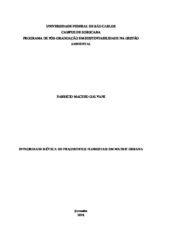| dc.contributor.author | Galvani, Fabricio | |
| dc.date.accessioned | 2018-09-14T17:03:10Z | |
| dc.date.available | 2018-09-14T17:03:10Z | |
| dc.date.issued | 2018-03-19 | |
| dc.identifier.citation | GALVANI, Fabricio. Integridade biótica de fragmentos florestais em matriz urbana. 2018. Dissertação (Mestrado em Sustentabilidade na Gestão Ambiental) – Universidade Federal de São Carlos, Sorocaba, 2018. Disponível em: https://repositorio.ufscar.br/handle/ufscar/10468. | * |
| dc.identifier.uri | https://repositorio.ufscar.br/handle/ufscar/10468 | |
| dc.description.abstract | In Brazil, semi-deciduous seasonal forest (SSF) is one of the physiognomies of Atlantic
Forests, and sited between the Atlantic Forest and Savanna Biomes. Over the last decades,
SSF has been fragmented by use of the soil for agricultural or urban areas. The urban and
industrial growth promote a strong impact in forest fragments due to the edge effects, isolation,
and habitat degradation. Hence, the knowledge about ecologic dynamics and biotic integrity
inside this fragment is essential to guide public policy and to support decision makers, in the
planning and management of territories. The goal of this study was to analyze the Biotic
Integrity in fragments of SSF inside Ribeirão Preto (SP), a medium-sized city in the southeast
of Brazil, and to analyse the relationship between BII and landscape metrics (size, shape and
connectivity). The method (BII) has nine indicators (littler and grass cover, stand of dead trees,
exotic wood species, vines, gaps in the canopy, vascular epiphytes, later species in canopy and
in understory). The results can vary from 9 to 45. The survey was carried out in 9 forest
fragments, the sizes of which are from 1,3 to 185,0 ha, all with urban influence. The relation
between IBI and landscape metrics (size, shape) were analyzed by the Pearson correlation. BII
value were registered from 26,0 to 38,0 or as low, medium or high integrity. The results showed
strong correlation between IBB and size (p= 0, 7944), and weakness with shape (p= 0, 47).
Therefore, the results show a vast area (77 ha) with low Integrity and another small area (22 ha)
with high integrity. It was registered a medium-sized area, with high integrity located urban
area in expansion, for which it was recommended the creation of one Protected Area. | eng |
| dc.description.sponsorship | Não recebi financiamento | por |
| dc.language.iso | por | por |
| dc.publisher | Universidade Federal de São Carlos | por |
| dc.rights.uri | Acesso aberto | por |
| dc.subject | Floresta Estacional Semidecidual | por |
| dc.subject | Fragmentos Florestais | por |
| dc.subject | Paisagem Urbana | por |
| dc.subject | Índice de Integridade Biótica | por |
| dc.subject | Semideciduos Seasonal Forests | eng |
| dc.subject | Urban landscape | eng |
| dc.subject | Forest Fragmentation | eng |
| dc.subject | Biotic Integrity Index | eng |
| dc.title | Integridade biótica de fragmentos florestais em matriz urbana | por |
| dc.title.alternative | Biotic integrity in forest reminiscent in urban areas | eng |
| dc.type | Dissertação | por |
| dc.contributor.advisor1 | Cardoso-Leite, Eliana | |
| dc.contributor.advisor1Lattes | http://lattes.cnpq.br/2186623269243747 | por |
| dc.description.resumo | No Brasil, a floresta estacional semidecidual (FES) é uma das fisionomias da Mata
Atlântica, situada entre os biomas Mata Atlântica e Savana. Nas últimas décadas, a FES foi
fragmentada pelo uso do solo em áreas agrícolas ou urbanas. O crescimento urbano e industrial
promove um forte impacto nos fragmentos florestais devido aos efeitos de borda, isolamento e
degradação do habitat. Assim, o conhecimento sobre a dinâmica ecológica e a integridade
biótica dentro desses fragmentos é essencial para orientar políticas públicas e apoiar os
tomadores de decisão no planejamento e gestão de territórios. O objetivo deste estudo foi
analisar a Integridade Biótica em fragmentos de FES no interior de Ribeirão Preto (SP), cidade
de porte médio do sudeste do Brasil, e analisar a relação entre a IIB e as métricas da paisagem
(tamanho, forma e conectividade). O método (IIB) possui nove indicadores (serrapilheira,
cobertura de gramíneas, árvores mortas em pé, espécies exóticas lenhosas, lianas, clareiras,
epífitas vasculares, espécies tardias no dossel e no sub-bosque). Os resultados do IBB podem
variar de 9 a 45. A pesquisa foi realizada em 9 fragmentos florestais, cujos tamanhos variam de
1,3 a 185,0 ha, todos com influência urbana. A relação entre o IBI e as métricas da paisagem
(tamanho, forma) foi analisada pela correlação de Pearson. O valor IIB registrado foi de 26,0
a 38,0 mostrando baixa, média ou boa integridade para os fragmentos. Os resultados mostraram
forte correlação entre IBB e tamanho (p = 0, 7944) e fraca relação com forma (p = 0, 47). No
entanto, os resultados mostraram uma área grande (77 ha) com baixa Integridade e outra
pequena área (22 ha) com alta integridade. Foi registrada uma área de médio porte, com alta
integridade, localizada em área de expansão urbana, para a qual foi recomendada a criação de
uma Área Protegida | por |
| dc.publisher.initials | UFSCar | por |
| dc.publisher.program | Programa de Pós-Graduação em Sustentabilidade na Gestão Ambiental - PPGSGA-So | por |
| dc.subject.cnpq | CIENCIAS BIOLOGICAS::BOTANICA::BOTANICA APLICADA | por |
| dc.subject.cnpq | CIENCIAS BIOLOGICAS::BOTANICA | por |
| dc.subject.cnpq | CIENCIAS BIOLOGICAS::ECOLOGIA | por |
| dc.subject.cnpq | CIENCIAS AGRARIAS::RECURSOS FLORESTAIS E ENGENHARIA FLORESTAL::CONSERVACAO DA NATUREZA::CONSERVACAO DE AREAS SILVESTRES | por |
| dc.subject.cnpq | CIENCIAS AGRARIAS::RECURSOS FLORESTAIS E ENGENHARIA FLORESTAL::CONSERVACAO DA NATUREZA::RECUPERACAO DE AREAS DEGRADADAS | por |
| dc.subject.cnpq | CIENCIAS BIOLOGICAS::ECOLOGIA::ECOLOGIA APLICADA | por |
| dc.subject.cnpq | CIENCIAS BIOLOGICAS::ECOLOGIA::ECOLOGIA DE ECOSSISTEMAS | por |
| dc.ufscar.embargo | Online | por |
| dc.publisher.address | Câmpus Sorocaba | por |
| dc.contributor.authorlattes | http://lattes.cnpq.br/0129627542515812 | por |

